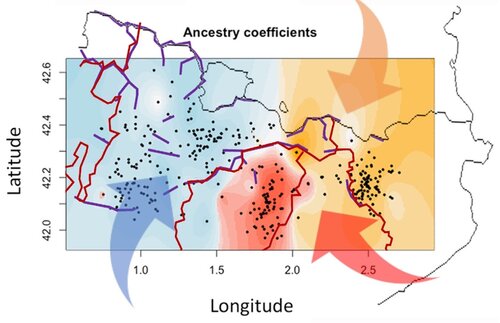The limits of the bishoprics and the abrupt mountainous orography shape the genetic profile of the rural populations of the Catalan Pyrenees
According to the GENPIR study financed by Lleida Provincial Council
A singular orography that has determined the establishment of administrative-religious boundaries, perpetuated unalterably for centuries, and the rigid social structure imposed by the Catholic Church over long periods of time have shaped the genetic structure of the population of the Catalan Pyrenees, according to the GENPIR study, which has analysed the genetic diversity of human populations in the territories of the Catalan Pyrenees. These findings have recently been published in the prestigious journal Frontiers in Genetics.
The multidisciplinary research by the University of Lleida (UdL), the Biomedical Research Institute of Lleida (IRBLleida), the Spanish National Research Council (CSIC) and the University of Barcelona, with the collaboration of the network of Pyrenean Hospitals and funded by the Lleida Provincial Council, shows that the rural populations of the Pyrenees present a unique genetic differentiation, where the limits established by the bishoprics and the orography have been social and physical barriers in the determination of their genetic profiles.
"All human populations share the same genetic background and the difference between populations lies in the frequency with which certain characteristics are present in each of them," explained Joan Fibla, lecturer at the UdL and head of the Genetics of Complex Diseases research group at the IRBLleida. "Geographical distance is a determining factor in the genetic differentiation between populations, which confirms the differences that can be observed between distant populations such as Asian and African populations or between African and European populations. Even so, close populations may show differences if there are geographical or socio-cultural barriers between them," confirmed Fibla.
The study, initiated in 2010 by Professor Pedro Moral of the Faculty of Biology at the University of Barcelona, was led by Joan Fibla and Oscar Lao of CSIC-Barcelona. The research involved the recruitment of almost a thousand volunteer participants born in the Pyrenees. Of these, 397 samples were chosen corresponding to unrelated people whose parents and maternal and paternal grandparents were born in the Pyrenees ("eight Pyrenean surnames"). Once the DNA of each participant had been obtained, more than 800,000 genetic characteristics were identified, making it possible to obtain a high-resolution genetic profile of each subject.
"The rural populations of the Catalan Pyrenees present a gradient of genetic differentiation in a west-east direction, which responds to both geographical and social factors, where the limits established by the bishoprics have played a determining role," said Fibla.
Article: Fibla J, Maceda I, Laplana M, Guerrero M, Álvarez MM, Burgueño J, Camps A, Fàbrega J, Felisart J, Grané J, Remón JL, Serra J, Moral P and Lao O (2023) The power of geohistorical boundaries for modeling the genetic background of human populations: The case of the rural catalan Pyrenees. Front. Genet. 13:1100440. doi: 10.3389/fgene.2022.1100440

In the image, we can see how the orography (purple lines), the limits of the bishoprics (red lines) and the historical migratory flows (arrows) have shaped the genetic profile of the rural populations of the Catalan Pyrenees (areas in colour)






